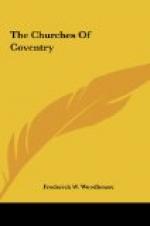The south transept, containing the Corpus Christi and Cellet’s chantries, has lost its original character completely. The piscina, high up on the south wall, shows that the floor level was some 9 feet above that of the church. The reason for this has been already explained. The organ chamber is quite modern. The best authorities place the chapel of the Butchers’ Gild in the south aisle of the chancel, but do not say to whom the eastern chapel in the nave aisle belonged. It is known that there was a Jesus Chapel, and, in view of the proximity of Jesus Hall, it is believed by some that this was its position.
The present clergy vestry is a fine room, having an excellent dark oak roof with heavy beams and well carved bosses at the intersections of the timbers. The Royal Arms over the fireplace were painted there in 1632. Although usual, the placing of the king’s arms in churches was not compulsory until the Restoration; few earlier now remain, and this placing of them in the vestry rather than the body of the church is suggestive of a compromise between opposing factions. A portrait of Walter Farquhar Hook, Vicar from 1828-37 and afterwards Dean of Chichester is hung here.
It seems probable that this was a chapel, perhaps that of the Holy Trinity, to whom an altar was dedicated.
The history, as traced in the church accounts, of the various organs used in the church gives some idea of the fluctuations of opinion as to the propriety of their use. In 1526 John Howe and John Climmowe, citizens and organ makers of London, contracted to provide, for L30, “a peir of Organs wt vij stopps, ov’r and besides the two Towers of cases, of the pitche of doble Eff, and wt xxvij pleyn keyes, xix musiks, xlvj cases of Tynn and xiiij cases of wood, wt two Starrs and the image of the Trinite on the topp of the sayed orgayns.” In 1570-the “payer of balowes” were sold, and in 1583 the pipes, “wayeng eleven score and thirteen pounds, went for fourpence half-farthing the pound.” In 1632 a new one was obtained but its life was short, for in 1641 the Puritan party caused it to be sold “for the best advantage.”
[Illustration: ALMS-BOX.]
Once more, in 1684, another was purchased from Mr. Robert Hay wood of the City of Bath for L100; then, in 1732, Thomas Swarbrick of Warwick built one for L600, for which a gallery was erected across the nave.
In 1855 this gave place to a new one by Foster and Andrews of Hull, costing L800; and this was rebuilt by Messrs. Hill and Son in 1900.
ST. JOHN BAPTIST’S CHURCH
[Illustration: CHURCH OF ST. JOHN BAPTIST, FROM BOND’S HOSPITAL.]




